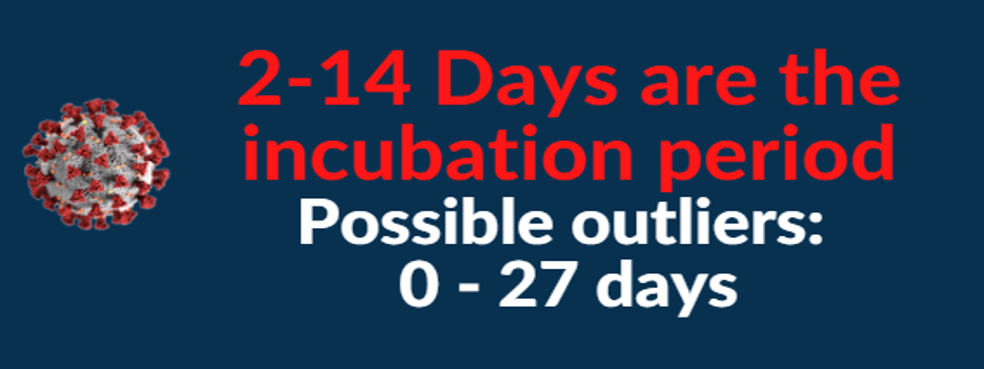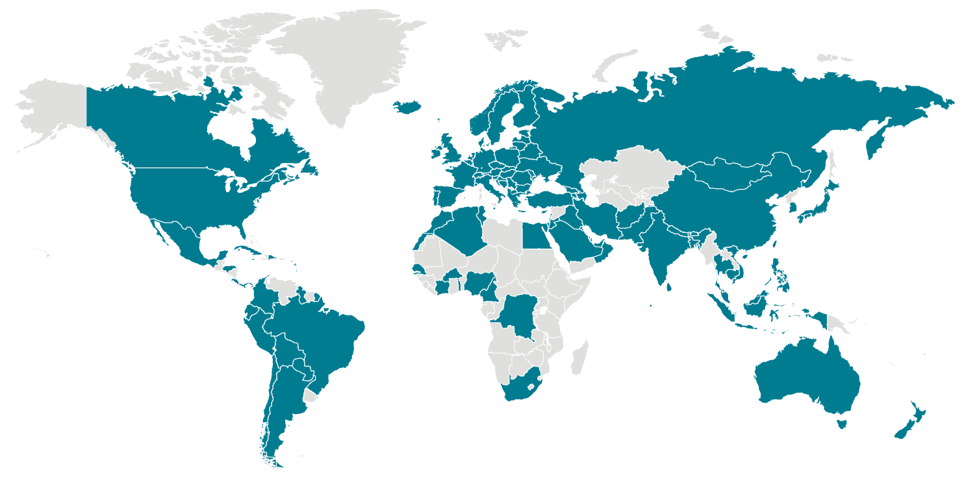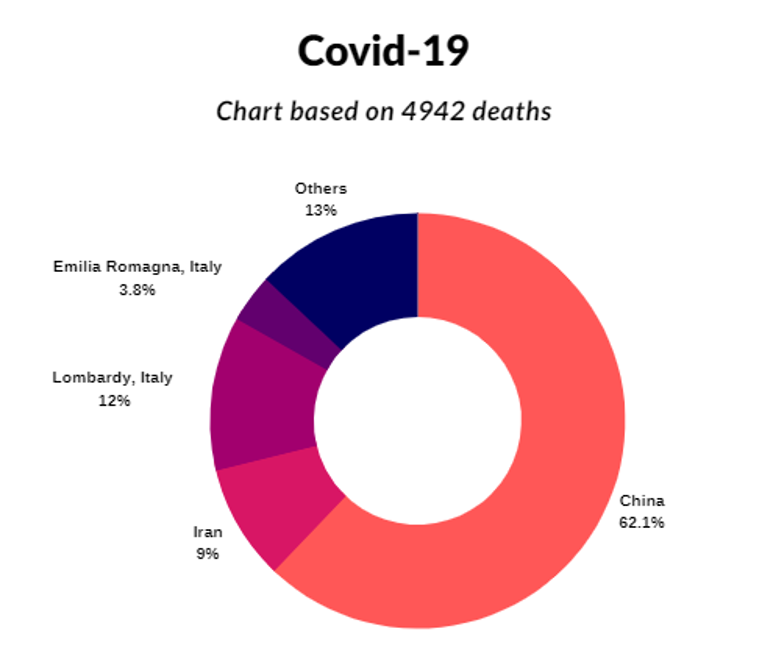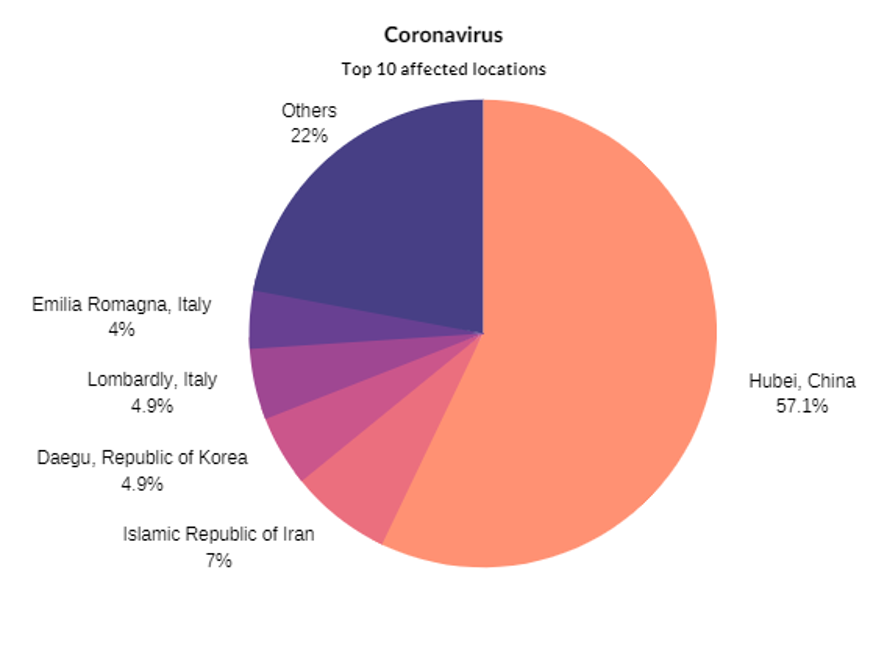COVID-19 Outbreak
Coronavirus Tracking: Map, Data, Worldwide (Real-Time Updates)
COVID-19, Coronavirus disease 2019, has been declared a pandemic by the World Health Organization on March 11, 2020. The virus ‘SARS-CoV-2’ is the reason for the outbreak of respiratory disease, which was first reported from Wuhan, China, and has reportedly spread to different countries crossing continents. Before declaring it as a pandemic, WHO placed it as PHEIC (Public Health Emergency of International Concern) on January 30, 2020, and after that, things shifted raising the alarm.
Overview of Coronavirus Tracking: Map, Data, Worldwide (Real-Time Updates)
- 1 Coronavirus Tracking: Map, Data, Worldwide (Real-Time Updates)
- 2 Source of the virus: (CDC)
- 3 corona virus cases by country
- 4 Coronavirus World Map
- 5 Biological family history of Coronavirus:
- 6 Symptoms: (CDC)
- 7 Transmission:
- 8 Incubation period: (Worldometer)
- 9 Age, sex and demographics factor of COVID-19: (Worldometer)
- 10 Confirmed cases country-wise (CDC)
- 11 List of countries with confirmed COVID-19 (CDC)
- 12 Top 10 affected locations: (Pharmaceutical Technology)
- 13 Causalities in major affected areas (Pharmaceutical Technology)
- 14 Corona cases in the US
- 15 Precautions: (CDC)
- 16 Conclusion:
Source of the virus: (CDC)
The epicenter of the Coronavirus outbreak is Wuhan, Hubei Province, China. Incidentally, Wuhan is one of the largest live animal and seafood markets. Ironically it is also one of the important biological weapon experimental centers in China. The possibility of spreading the virus from animal to person remains very strong, because of the large-scale live animal trade happens in Wuhan. It is interesting to note that soon after the disease started spreading other parts of China, including those areas where no animal or seafood market, it suggests the possibility of virus spread from person to person.
corona virus cases by country
Until now, 118 countries have infected by Coronavirus 2019, and every moment news reports have been beaming with the latest entries in the list. It is alarming and creates chaotic situations all over the world. The repercussions are beyond our imagination. The data below is extracted from the WHO pages and local news updates.
| Country | cases | deaths | Recovered | recovery rate, % | fatality rate, % |
|---|
Coronavirus World Map
- Black: Cities with 1,000 or more cases
- Purple: Cities with 100 or more cases
- Red: Cities with 20 or more cases
- Orange: Less than 20 cases
- Diamond shape: Cities with deaths
Biological family history of Coronavirus:
COVID-19 (Coronavirus disease 2019) is part of an extended virus family which has the potential to spread from animal to person and then spread rapidly from person to person. There are different forms of the virus of this family, which are present in cattle, bats, camels, cats, snakes, and many other animals. They are less prone to jump from animal to person; however, viruses such as SARS-CoV and MERS-CoV have the notorious ability to jump to people and the new variation SARS-CoV-2, which later christened as COVID-19, which stares like a demon on the human race.
The presence of SARS-CoV-2 is prominent on bats. SARS-CoV-2 is very similar to SARC-CoV and MERS-CoV and is a betacoronavirus. The clinical history of patients is very much matching with the symptoms of betacoronavirus. Hence, the possibility of the virus outbreak is from a live animal trade center or human likely to have close interaction. That is the reason, theoretically, it can confirm beyond doubt that the live animal market in Wuhan could be the outbreak point of the disease.
Symptoms: (CDC)
Not all fevers are the symptoms for COVID-19. So, no need to get panic if you don’t have breathing issues, fever, and dry cough. The main symptom of coronavirus are as follows:
- Fever with dry cough and breathing difficulties.
If you feel a combination of all these symptoms, then it could be a warning signal, and you must seek medical help. Check also the following condition; if you have the following warning symptoms, then it is possibly an indication of COVID-19.
- Feeling of pressure in the chest or continuous pain.
- Breathing issues or shortness of breath.
- Bluish lips or face.
- Inability to arouse or confusion.
Transmission:
Coronavirus can transmit from animals to the human being, hence are known as zoonotic. The virus is part of a large family, and there are many viruses common in animals without infecting human breed. These viruses are a reason for the common cold to chronic diseases such as SARS-CoV (Severe Acute Respiratory Syndrome) and MERS-CoV (Middle East Respiratory Syndrome). SARS-CoV is ubiquitous in civet cats, and MERS-CoV is common in camels and from where humans get infected.
General symptoms of diseases are respiratory issues, cough, fever, etc. When it affects severely, it may lead to kidney failure, chronic respiratory disorders such as breathing problems, and also a reason for causing pneumonia. Once the COVID-19 infected, it spread rapidly even though it cannot survive more than 25-30 minutes outside the human body. (WHO)
Incubation period: (Worldometer)

Within 2 days or a maximum of 14 days, the virus has the potential to become/remain contagious. However, the patient does not necessarily show any symptoms of infection.
- WHO estimates the incubation period for COVID-19 is 2 to 10 days.
- National Health Commission of China (NHC) estimates the incubation period between 10 and 14 days.
- As per CDC USA, the incubation period must be 2 to 14 days.
Age, sex and demographics factor of COVID-19: (Worldometer)
The statistics of COVID-19 shows, the majority of elderly citizens were the victims of the infectious disease. As per NHC, China, the following information exposes the vulnerability of senior citizens and people who had some medical issues.- 80% of people who died due to coronavirus infection were above 60 years of age.
- 75% of people had health issues.
- As per WHO, the median age of infection was 45 years, and the virus exposed between 2 to 74 years.
- 71% of the infected people were Males
What you must-do if you fall sick? (CDC)
Everybody must be knowing what one must do if they fall sick. Since we are passing through the pandemic period, don’t keep a lackluster attitude. Let us all conscious about the following practices.
- Call your doctor.
- Do not go out.
- Call your healthcare provider and explain the situation. By confirming the possibility of infection with the given symptom, the health care provider must be in a better position to stop it from spreading to others.
- If you are not seriously ill, then remain at home and take the following homecare practices.
- Stay home.
- Stop visiting all public areas.
- Do not use public transport systems.
- Do not let others come near to you.
- Avoid animal and pets contact.
- Take an appointment before visiting your doctor.
- Call your healthcare provider and inform your visiting plan.
- Wear a mask. Change mask every 6 hours.
- Cover your mouth and nose while coughing or sneezing.
- Discard/dispose of used tissues.
- Wash your hands with soap at least for 20 seconds.
- Avoid touching public places, your nose, eyes, and mouth.
- Do not share personal household items.
Confirmed cases country-wise (CDC)

- Confirmed cases 133,889 as of March 12, 2020 (Pharmaceutical-technology)
- Deaths 4,942 as of March 12, 2020 (Pharmaceutical-technology)
- Recovered: 68,887 as of March 12, 2020 (Pharmaceutical-technology)
- Infected countries 118 (Pharmaceutical-technology)
List of countries with confirmed COVID-19 (CDC)
Until now, 118 countries have infected by Coronavirus 2019, and every moment news reports have been beaming with the latest entries in the list. It is alarming and creates chaotic situations all over the world. The repercussions are beyond our imagination.South American Continent:
- Argentina
- Brazil
- Bolivia
- Chile
- Colombia
- Costa Rica
- Dominical Republic
- Ecuador
- French Guiana
- Guadalupe
- Honduras
- Jamaica
- Martinique
- Mexico
- Panama
- Paraguay
- Peru
North American continent
- Canada
- USA
Africa
- Algeria
- Burkina Faso
- Cameroon
- Democratic Republic of Congo
- Nigeria
- Senegal
- South Africa
- Togo
Europe
- Albania
- Andorra
- Armenia
- Austria
- Azerbaijan
- Belarus
- Belgium
- Bosnia and Herzegovina
- Bulgaria
- Croatia
- Cyprus
- Czechia
- Denmark
- Estonia
- Finland
- France
- Georgia
- Germany
- Gibraltar
- Greece
- Hungary
- Iceland
- Ireland
- Israel
- Italy
- Latvia
- Liechtenstein
- Lithuania
- Luxembourg
- Malta
- Moldova
- Monaco
- Netherland
- North Macedonia
- Norway
- Poland
- Portugal
- Romania
- Russia
- San Marino
- Serbia
- Slovakia
- Slovenia
- Spain
- Sweden
- Switzerland
- Turkey
- Ukraine
- UK
- Vatican City
Asia and South East Asia
- Bangladesh
- Bhutan
- India
- Indonesia
- Maldives
- Nepal
- Sri Lanka
- Thailand
Mediterranean countries and Eastern Mediterranean
- Afghanistan
- Bahrain
- Egypt
- Iran
- Iraq
- Jordan
- Kuwait
- Lebanon
- Morocco
- Oman
- Pakistan
- Qatar
- Saudi Arabia
- Tunisia
- UAE
Australia and Western Pacific
- Australia
- Brunei Darussalam
- Cambodia
- China
- Hong Kong
- Japan
- Macau
- Malaysia
- New Zealand
- Philippines
- Republic of Korea
- Singapore
- Taiwan
- Vietnam
Top 10 affected locations: (Pharmaceutical Technology)
Causalities in major affected areas (Pharmaceutical Technology)

Corona cases in the US
Ever since the global outbreak of Coronavirus (COVID-19), in the USA, 1,629 cases have reported. Out of this, 41 people have succumbed to their illness. So far, 47 states have reported virus infections as per the daily report published by the CDC. The facts and figures are likely to change due to frequent updates.Source of infections:
The categorized sources of infections are as follows.- Infected due to travel – 138 cases
- Personal contact, due to personal care/attention – 129 cases
- Under investigation – 1,362 cases
- Total cases – 1,629
Precautions: (CDC)
The following are the recommended precautions everyone must follow to check the spread of coronavirus.- While nursing a sick person avoid close contact.
- Adhere to the following preventive methods.
- Keep your hands clean.
- Wash your hands frequently.
- Make it a practice to wash your hands completely by covering all the areas, including the wedges of the fingers with soap and water for 20 seconds. Do it often, whenever you are back from a public place, after coughing, blowing your nose or sneezing.
- Use a hand sanitizer which has a minimum of 60% alcohol if you don’t have soap and water.
- While at public places, avoid touching high-risk areas like handrails, elevator buttons, door handles, etc.
- Avoid handshakes.
- Use a tissue paper if you want to touch a common surface area and avoid touching the surface with your fingers.
- Clean your hands by washing after touching the objects that are commonly using in public places.
- Do not touch your eyes, nose, tongue, and face frequently.
- Disinfect your home appliances, switches, handles, sinks, cell phones, faucets, doorknobs, and furniture, etc., to neutralize germs.
- Do not venture into crowded areas. It is better to avoid congested areas.
- Avoid poorly ventilated areas.
- Travel only if it is a must. Try to postpone all types of the journey unless it is urgent.
- Avoid cruise ship journeys.
- If the virus hits your community, do not let others come close to you or you go to them. Keep a safe distance always. Keeping a minimum of 1 meter is safe to resist the infection.
- Do not venture out and try to be at home. Avoid all journeys if it is not inevitable.
Precaution plans if you get sick:
- Restrict your contact by email or phone.
- If you fall sick, seek help from health workers, family, friends, or neighbors.
- Consult with your health care worker on how to monitor the symptoms of COVID-19 and follow the instructions carefully.
- Make plan #2 if your caregiver also gets sick.
Conclusion:
Clinical trial for treating COVID-19 is still in the early stage, and as of now, we don’t have a complete picture of the virus. Most of the patients had reported mild headaches and breathing disorders. People who had severe headaches and breathing problems had succumbed to the virus attack. The deadly attack of the virus comes about 16% of the total infection. Senior people and people with underlying medical issues, such as cardiovascular conditions and diabetics are more prone to get infected by COVID-19.Explore Related reccomendations
Mobile Gaming Statistics, Revenue, Industry Data (2020 Report)
- According to 0 users
Most popular mobile messenger apps Worldwide 2020
- According to 0 users
YouTube Statistics,Trends & Data (2019)
- According to 0 users
The Biggest Data Breaches by Region & Sector
- According to 0 users



